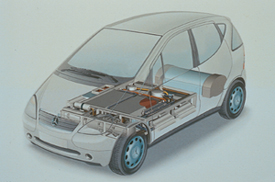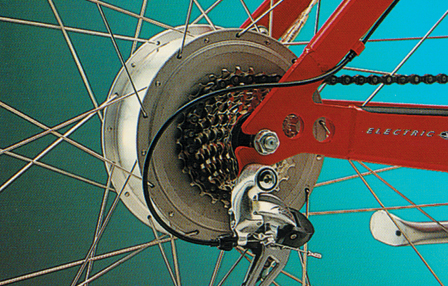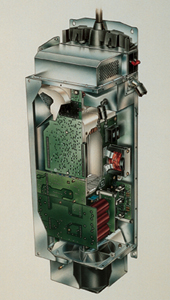Copper-Wound Motors Help Lessen Air Pollution
 DaimlerChrysler's five-passenger Necar 4, a fuel-cell-powered auto that can travel nearly 280 miles at up to 90 mph before refueling with hydrogen gas.
DaimlerChrysler's five-passenger Necar 4, a fuel-cell-powered auto that can travel nearly 280 miles at up to 90 mph before refueling with hydrogen gas.Copper is making a major contribution to improving the environment, specifically in lowering air pollution. The major gain is through the introduction of all-electric or hybrid electric/ internal-combustion vehicles, a concept first patented in 1897. Driven by high-efficiency, copper-wound motors, quiet vehicles from one-passenger scooters to multi-passenger buses don't add to city air pollution or noise levels.
The electric traction motors of hybrid vehicles obtain their power from batteries while in the city. In suburbs and rural areas, their internal-combustion engines can take over to provide power to the traction motors and recharge the batteries.
Electric vehicles get their power either from batteries or fuel cells, a technology that originated in 1839. DaimlerChrysler exhibited its first fuel-cell-powered vehicle, the Necar 1 (newcar) five years ago. Necar 4, the latest incarnation, can reach speeds of 90 mph. The giant carmaker has also just shown a fuel-cell- powered Jeep, the Commander sport-utility concept vehicle.
 The Dodge ESX2, with a three-cylinder diesel driving a generator to supply power to its electric traction motors and to recharge its lead-acid batteries. To extend range, the motors help recharge the batteries by means of dynamic braking
The Dodge ESX2, with a three-cylinder diesel driving a generator to supply power to its electric traction motors and to recharge its lead-acid batteries. To extend range, the motors help recharge the batteries by means of dynamic brakingLast year, Chrysler, before its acquisition by Daimler, introduced the Dodge Intrepid ESX2, a hybrid diesel/electric car. None of these experimental vehicles is expected to result in production models until the year 2004.
Even more effective fuel cells are in the offing because DaimlerChrysler, the Ford Motor Company and Royal Dutch/Shell Group have invested a whopping $750 million in Ballard Power Systems, Inc., a leader in fuel-cell technology. This R&D operation is based in Burnaby, British Columbia. An experimental bus powered by its fuel cells is operating in nearby Vancouver, B.C. Not surprisingly, all the other major carmakers, such as GMC, Toyota, and BMW, are also developing fuel-cell-powered vehicles.Battery-powered Bikes
Bikes with electric drives are now available from more and more manufacturers-last year about $200 million worth of electric bikes were sold worldwide. In the USA, the volume leader is Zap Bikes, Sebastopol, California. A spokesman claims it has sold over 22,000 bikes, kits to add electric drives to conventional bikes, and fold-up electric scooters. Zap's first electric bike was introduced in 1994. Essentially, it adds electric drives to conventional bikes that can still be pedaled in the usual manner if the rider wants to extend its range.
The 300-watt motors are supplied by Revcor, Austin, Texas. They are waterproof copper-wound motors originally designed to drive the fans cooling the motors of big trucks. A Zap spokesman claims that some 150 law-enforcement agencies have purchased its bikes. Zap's electric bikes are also sold in Europe.
E-Bike, marketed by EV Global Company, Los Angeles, has a top speed of 15 mph and a range of up to 20 miles. EV Global is backed by Lee Iacocca, retired head of Chrysler, and Robert C. Stempel, former CEO of General Motors. The E-Bike, manufactured in Taiwan, is powered by a 400-watt motor made by Heinzmann in Germany. The motor, mounted in the front-wheel hub, is energized by a 24-volt battery with a capacity of 8 ampere-hours. To conserve battery power, the 69-pound bike can be driven by leg power in the conventional way.
 E-Bike's rear wheel hub conceals copper-wound motor.
E-Bike's rear wheel hub conceals copper-wound motor.The 20-pound, lead-acid battery is recharged by plugging into any conventional outlet because the re- charging module is part of the battery pack. It takes four hours to recharge the battery. EV Global also is developing a tandem, tricycle bike as an energy-efficient replacement for both gas-powered and electric golf carts, according to engineer Michael Fritz. In time, EV Global hopes to introduce an electric car.
Electric motorcycles and bikes have been developed by AeroVironment, which has also developed drives (batteries, motors and gearing) for prototype electric cars. Its electric bike is marketed by its subsidiary, Charger Electric Bikes, Monrovia, California, where AeroVironment is based. Initially, the prototype electric bikes were tested by police departments fielding bike-equipped patrols.
Essentially an R&D operation, AeroVironment has also developed fast-charging systems for electric vehicles, including fork lifts and airport ground-support vehicles. Its PosiCharge EV chargers permit an electric vehicle to regain half its range in under 10 minutes. The systems (see illustration) from Delphi that GMC uses to recharge its electric cars rely on from 5 to 12 pounds of copper each.
Pollution Monitor
 The Delphi inductive charging unit used by GMC to recharge its electric cars uses up to 12 pounds of copper.
The Delphi inductive charging unit used by GMC to recharge its electric cars uses up to 12 pounds of copper.The lightweight aircraft have already set altitude records for propeller-driven aircraft. Their next goal is 100,000 feet. Besides their obvious military application in surveillance, the drones could also monitor the weather. And, if equipped with solar cells, they could presumably stay aloft for days.
Tug Technologies, Inc., Kennesaw, Georgia, makes the electric tractors that haul luggage carts around airports. Because of all the unavoidable pollution from jet engines, airports prefer electric ground-support vehicles to avoid adding even more pollution.
Copper makes another small but growing contribution to higher air quality. World-wide, some 26,000 wind-driven generators are already creating much electricity without the slightest pollution.
AeroVironment: 626/357-9983
Ballard: 604/454-0900
Charger: 888/710-4321
Delphi Automotive Systems: 248/813-2000
EV Global: 800/871-4545
Tug: 770/422-7233
Zap: 707/824-4150
Also in this Issue:
- Bronze Endures Beneath The Sea
- Copper Cable Enables High-Speed Communications
- Copper Enhances Manufactured Home
- Copper Protects Historic Buildings
- Copper-Wound Motors Help Lessen Air Pollution
